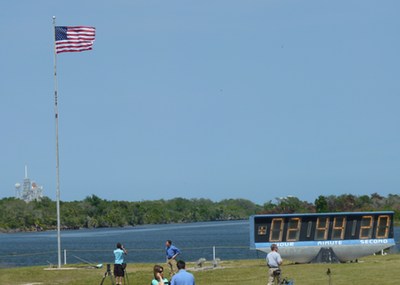Pomp and circumstancesby Dwayne A. Day
|
| But what is the symbolism of the shuttle? There are lots of answers to that question, and they depend upon your worldview. |
I will not lie and say that this article was going to be full of amazing insight, but my hope was that it would at least be, well, thought-provoking (of course, that is my hope for all of my articles). The royal wedding and a shuttle launch have similarities, and also profound differences. They both attract large audiences who at best participate vicariously. And they both inspire fantasies. For a mostly female audience, the royal wedding allows women to fantasize about being princesses, and for a majority male audience, a shuttle launch, and spaceflight in general, allow men to fantasize about exploring new worlds, or settling frontiers. Neither fantasy is terribly grounded in reality. Although one could argue that the royal wedding is an arcane tradition involving an anachronistic institution that has long outlived its usefulness, cynics could argue that the same applies to the shuttle program—it is an amazing piece of 1970s-era technology that costs a lot of money and does not actually accomplish much. Fortunately, I’m not that cynical, at least not all the time. At least not today.
It is always dangerous applying too much symbolism to events, be they random (i.e. earthquakes) or scheduled (elections, shuttle launches). In the case of the royal wedding, it is steeped in symbolism by design. That is the entire point of the monarchical industrial complex, to generate symbolism, along with a lot of meaningless blather by observers (what exactly do newsreaders mean when they say that Will and Kate will be “a very modern couple?” They’re going to spend the rest of their lives opening shopping malls and attending charity events, not designing microchips or decoding genomes—what’s so “modern” about that?). If you want to be cynical—and despite what I wrote above, I am cynical about monarchy and any cultural system predicated on bloodline superiority—then the royal wedding symbolizes a society that likes to pretend at greatness long past. All that spectacle comes at a time when the Royal Navy is selling off its aircraft carriers and scrapping Harriers and the Royal Air Force is decommissioning fighter wings.
But what is the symbolism of the shuttle? There are lots of answers to that question, and they depend upon your worldview. Some would argue that the shuttle symbolizes the greatness of a fading superpower. At some level, the shuttle symbolizes American ambition and achievement. But the problem with symbolism is that it over-simplifies the world. It’s easy to consider big events, and big pieces of technology, as symbols of greatness. But today’s reality is that the most important pieces of technology, and American greatness, are tiny. The iPad and its operating software are pretty amazing, but they are much harder to hold up as symbols of American capabilities, even if they are far more portable than a space shuttle.
So the shuttle didn’t launch. I’m sure that it will launch soon. And I’m sure that I’ll be far more impressed by that launch than I am of a marriage of a couple of rather bland representatives of a former ruling class showing off their empire’s superiority in wedding gown technology.
Go Endeavour, show them what the colonies can still do.
